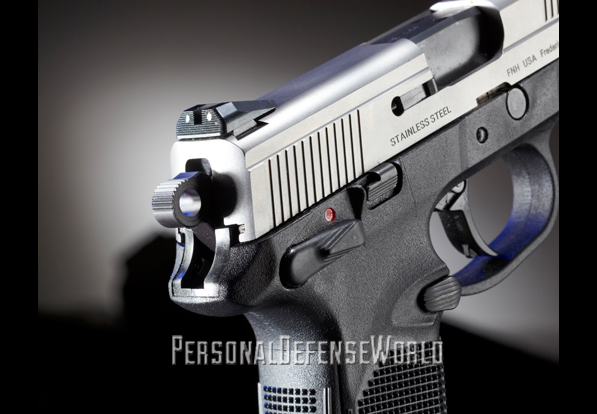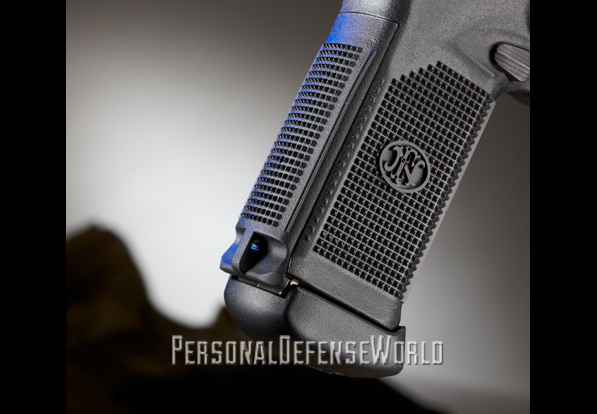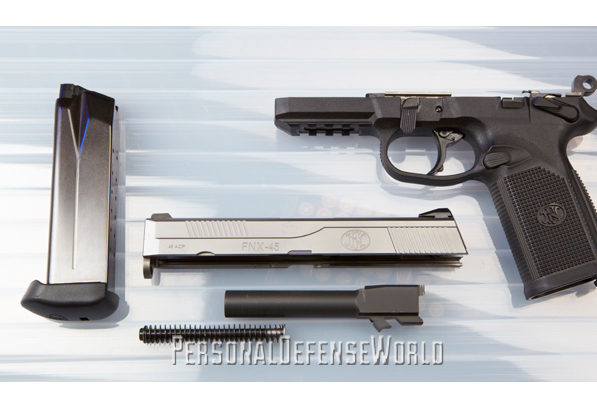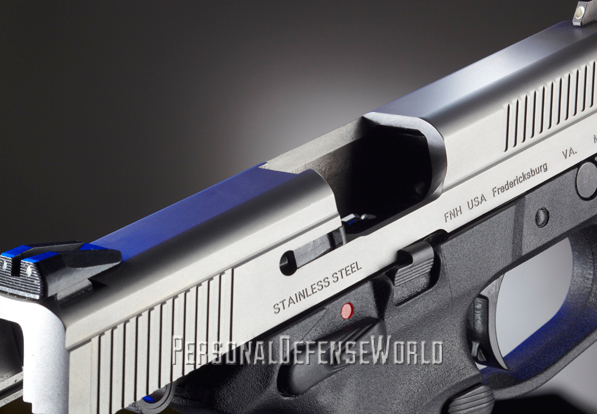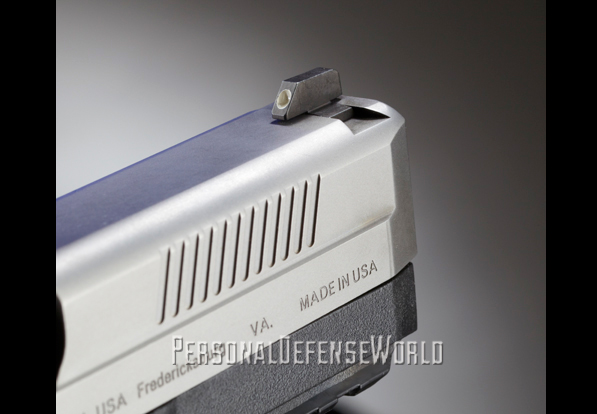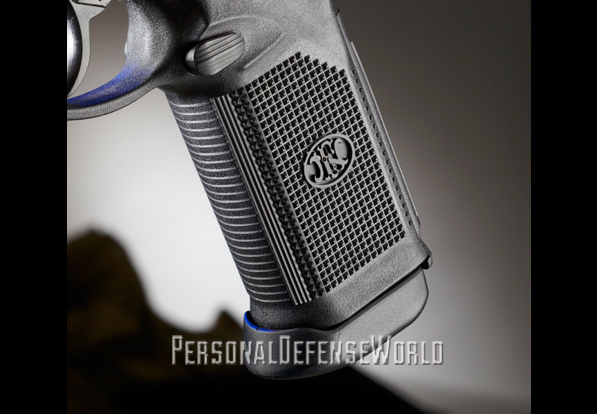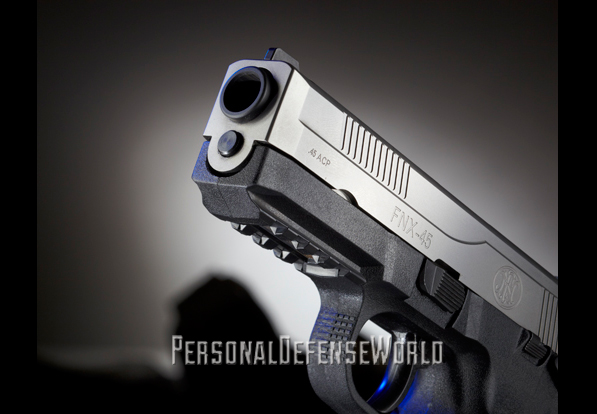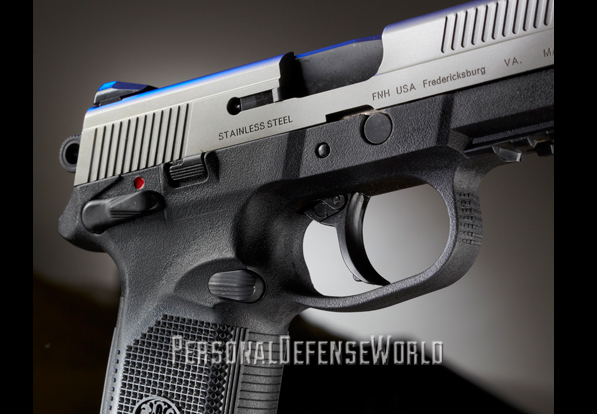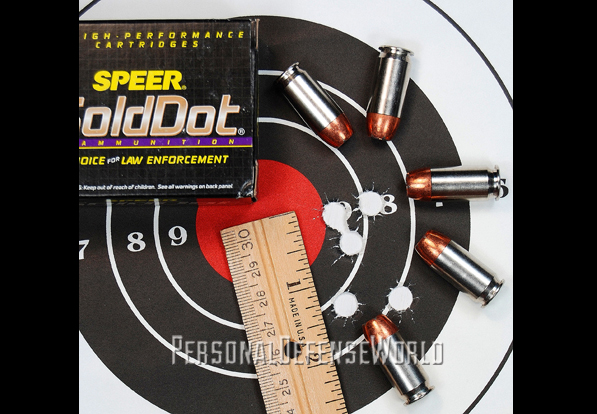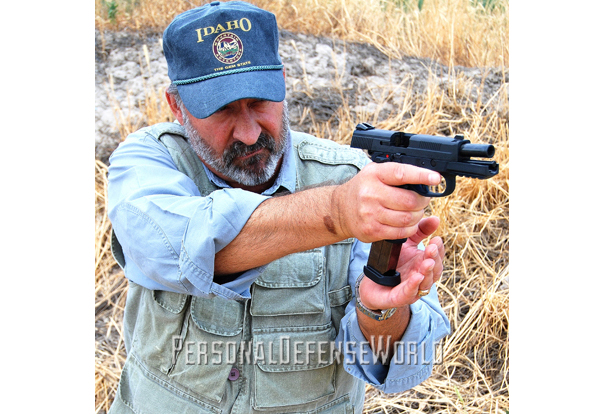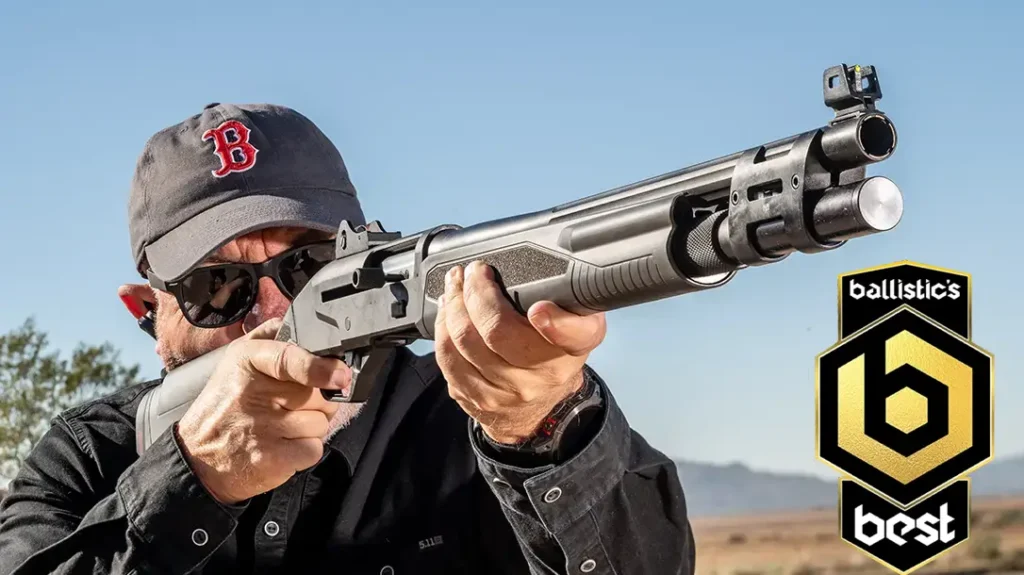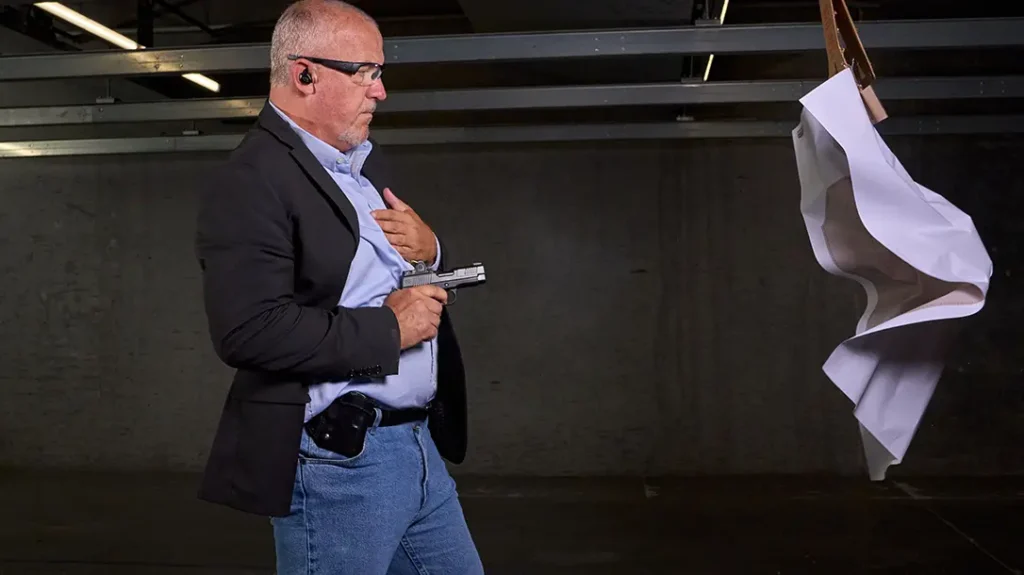In today’s crowded market, a new polymer-framed pistol doesn’t generate quite the attention it did 30 years ago. Once new and radical, an entire generation of shooters has grown up with them, and if you judge by popularity and the number of polymer-framed pistols sold and carried regularly coast to coast, polymer is now the new mainstream in terms of high-capacity duty and concealed carry artillery.
Most tend to be either mid-sized or compact pistols, catering to law enforcement for duty and everyday comfort for those who pack daily, public or private, and the field thins considerably when you start looking for a full-sized, high capacity semi-auto in something above a .40 caliber. The bigger .45 ACP round dictates a bigger .45 ACP launching platform, and the more rounds you try to cram into the magazine, the bigger the magazine has to be, too. Most conventional .45 makers hold the line at nine or so rounds in capacity, trying to keep the pistol’s overall dimensions trim enough to appeal to the majority of their potential customers. As a rule, the idea works. As such a pistol grows in size, its market conversely shrinks, and since most makers like to sell in large volume, challenging the bell curve can be risky. Fortunately, there are companies that’ll take that risk, gambling on attracting a consumer segment mostly ignored by others, and Fabrique Nationale (FN), by way of its Columbia, South Carolina, operation, is one of them.
With a rock-solid history of manufacturing military and civilian weapons, Belgium-based FN has been moving forward and away from traditional products like the classic steel Browning Hi-Power (still manufactured for Browning) and into the more modern camp with its newer FNX series introduced in 2009. Riding the polymer tide, these pistols offer fully competitive features and are chambered in 9mm, .40 S&W or .45 ACP. In the big-bore autopistol arena, there isn’t much that competes directly with the FNX-45, and while it’s not one that’ll appeal to the largest demographic of that aforementioned bell curve, if your motto is “bigger equals better,” you should take a look.
Advertisement — Continue Reading Below
Gun Details
First off, we should make it perfectly clear that the FNX-45 is no pocket pistol. Introduced in December of 2012 and based loosely on the FNP-45 pistol developed for the U.S. military’s Joint Combat Pistol program in 2007, the large-framed FNX-45 is a sizable handful by anybody’s standards, and it certainly could be concealed with sufficient motivation by people determined to carry it more or less invisibly, but its best role lies in open carry in either duty holsters or woodsy surroundings where such things are permitted. It’s also a good option for home defense, since no unlawful invader will enjoy seeing this muzzle at 3 o’clock in the morning. Within these parameters, FN’s new .45 has quite a bit to offer.
The FNX-45, despite its size, isn’t a heavy pistol at 33.2 ounces empty (compared to a typical steel 1911 weighing 35 ounces) thanks to its lightweight frame. To continue the comparison, its 4.5-inch barrel is obviously half an inch shorter than the 1911’s 5-inch standard barrel. It’s the beef in the slide and the thickness of the frame that bulk the FNX-45 up, combined with the girth and length of the grip. With a thickness of 1.58 inches and a height of 6.3 inches, it’s distinctly challenged in the “svelte” category, which makes it problematic for concealment purposes and a definite non-contender for casual beach wear. On the other hand, its size does work in favor of a solid shooting grip, and the big .45’s features have some notable positives, not the least of which is its 15-round magazine capacity.
Starting at the bottom and working up, the grip is wide to fit in all those .45 ACP rounds in a steel, double-stack magazine made in-house at the same U.S. plant where the rest of the pistol is manufactured. Flat-sided, the grip section is aggressively checkered on both sides, and the front and backstraps have horizontal serrations to further anchor the pistol in your hand. The FNX-45 also comes with two removable backstrap inserts to help it fit your very own personal hand size. One’s
flat; the other’s arched. To easily remove/install an insert, poke a small punch or paper-clip into the tiny hole about
an inch up from the bottom of the insert to depress the internal detent and slide it on or off. You decide which insert works best.
Advertisement — Continue Reading Below
The FNX-45 also utilizes a true ambidextrous magazine release; the serrated, steel, teardrop-shaped button works from either side as it comes. There’s no need to disassemble and reverse anything for lefties—it’s already fully functional with either hand and ready to go out of the box. The rest of the pistol’s controls are fully ambidextrous, aside from the takedown lever on the left side of the frame, above the large triggerguard. Both the safety/decocker and the slide lock lever are present on both sides of the frame, and both are easy to reach with the thumb without losing a firing grip. The number of semi-autos that come truly set up for ambidextrous use from the get-go is quite small, and this pistol gets bonus points for being one of them.
The trigger, made of polymer, is attached to an internal double-steel drawbar that runs the double-action/single-action (DA/SA) mechanism, providing three loaded-chamber carry options: hammer-down DA with the safety on, hammer-down DA with the safety off, and “cocked and locked” with the hammer cocked and the thumb safety on. The thumb safety disconnects the trigger when the hammer’s down and riding in its at-rest position off the firing pin and when the hammer is fully cocked. The same lever can decock the hammer at any point after firing or after chambering the first round, if desired, for holstering. It does not lock the slide (so the pistol can be de-chambered for unloading with the safety on), and the passive firing-pin block in the slide stops the pin from moving forward as a drop safety unless the trigger is pulled with the safety off.
FN has followed the common practice in recent years of incorporating a loaded-chamber indicator on the short external extractor. When the extractor is pivoted outward by a chambered case far enough to see the dab of red paint on top, a quick glance shows the pistol is loaded. The ejection port is large, the thick and hefty slide itself has cocking serrations at the front and rear that make slide manipulation quite easy, steel fixed sights use a standard three-dot system, the rowel hammer is nicely serrated on top for SA thumb-cocking, and the frame includes the fashionable Picatinny rail for mounting accessories. An additional plus that most other designs do not include, however, are the pistol’s replaceable steel frame rails. While these are not a high-wear or failure-prone aspect of the package, the ability to get them replaced at the factory somewhere down the road if you do shoot the gun enough to create serious rail wear means the difference between retiring a worn-out frame or merely re-building it and carrying on as usual. Finally, looking inside, you’ll notice a captive recoil spring on a steel guide rod.
Advertisement — Continue Reading Below
Rounds Downrange
No system can be any better than the sum of its parts, and the FNX-45 adds up pretty well when it comes time to make noise with it. The size of the FNX-45 right out of the box, in my medium hands, felt quite different from the usual .45 ACP pistols I’m used to, but as range time progressed, I got used to it. The grip configuration and texturing allow for a very solid firing grasp, and once I got out of the high-thumbs hold I normally use with a 1911 and locked both thumbs together below the safety, recoil management progressed.
Everybody knows that a lightweight handgun with an alloy or polymer frame will tend to produce more muzzle rise than an otherwise identical model in the same caliber with a steel frame, but not everybody understands why. A good part of the reason is that the pistol tries to rotate around its center of mass (axis) under recoil. Since the barrel is normally above the center of mass, and the grip is below it, the gun tries to spin at the same time recoil forces creating Newton’s famous equal-and-opposite reaction try to shove the pistol backward, away from the direction the bullet travels. Omitting any further physics theories, that means the muzzle tips up while the pistol tries to tip the grip down. Since your hand impedes the grip part of the frame from spinning, most of the energy goes into raising the muzzle and shoving the entire handgun backwards. Besides your hands resisting the pistol’s attempted spin, a heavier steel frame adds further resistance with its greater weight. The net result is that you get at least slightly less perceived recoil in a steel-framed pistol than a polymer-framed pistol, and a polymer-framed version can be slightly harder to control in rapid fire. During the range session, I found the large grip worked to make the big .45 much more controllable than I’d expected. During rapid fire, at least the first half of the magazine literally outweighs any recoil disadvantage the polymer frame has over a more conventional steel-framed pistol with a lower magazine capacity.
Reliability is infinitely more important in a defensive piece than target-grade accuracy, and there were no malfunctions whatsoever throughout the test session, despite my violating the manual’s instructions to clean the storage preservative out and lube the pistol correctly before firing it (please follow the manual’s instructions). Its accuracy? Each of the five JHP loads tested produced best groups inside 3 inches, with Speer’s 185-grain Gold Dot HP creating a 5-shot group measuring 1.38 inches at 25 yards.
Advertisement — Continue Reading Below
Final Notes
The sights are visible, I always prefer a steel guide rod, the thumb safety/decocker is accessible and positive, the 5-pound SA trigger pull is smooth with a slightly springy break, the reach is good despite the pistol’s size, the oversized triggerguard is excellent for gloves as well as for quickly getting that finger down off the frame and on the trigger from “in-hand standby” to “GO!” and the pistol breaks down quickly and easily for cleaning via the rotating takedown lever that allows the slide to ride forward off the frame. My test sample came with three of the Tactical model’s extended magazine baseplates; those that normally come with any of the three standard models use a flat baseplate. Either type can be ordered separately at $50 each.
All together, FN builds a boatload of handy features into the FNX-45 for a suggested retail price of $809. If you’re looking for a full-sized, polymer-framed, ambidextrous semi-auto with 16 rounds of .45 ACP firepower on tap, the FNX-45 is ready to go right off the line, and for left-handed buyers especially, that’s a bargain. For more information, visit fnhusa.com or call 703-288-3500.
BUY NOW! AT www.personaldefenseworld.com/subscribe/handguns-buyers-guide/.
Advertisement — Continue Reading Below

